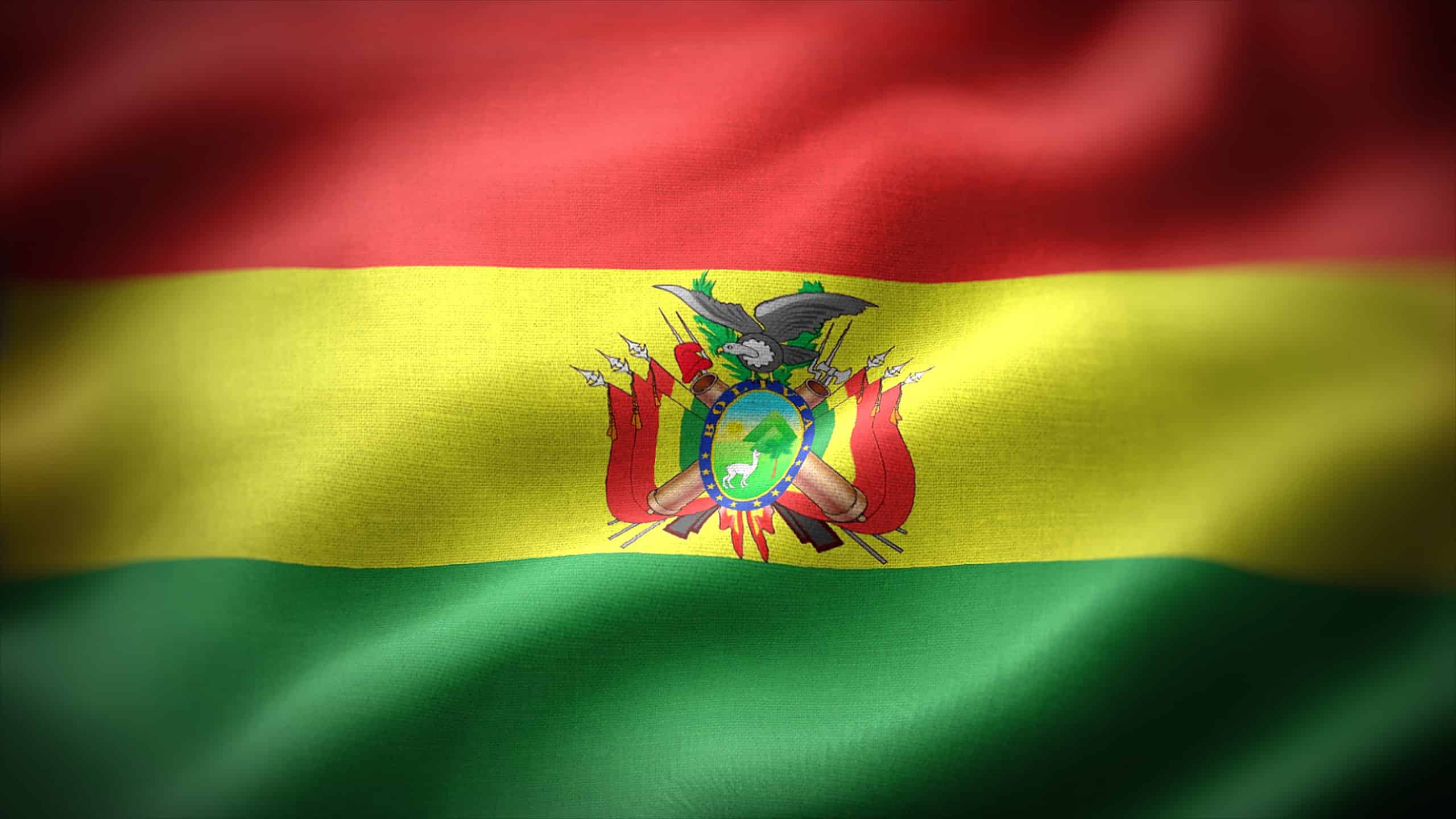In this article, we’ll examine seven countries with green, yellow, and red flags. Although many flags feature these three colors, we’ll be focusing on those in which the green appears first, followed by the yellow, and then the red. These tricolor flags may be read both left-to-right and right-to-left, as well as from the top down or the bottom up.

At present, we are discussing the flags of Bolivia, Ethiopia, Ghana, Guinea, Mali, the Republic of the Congo, and Senegal. We’ll take a quick look at the history, design, and symbolism for each of these below.
The Flag of Bolivia
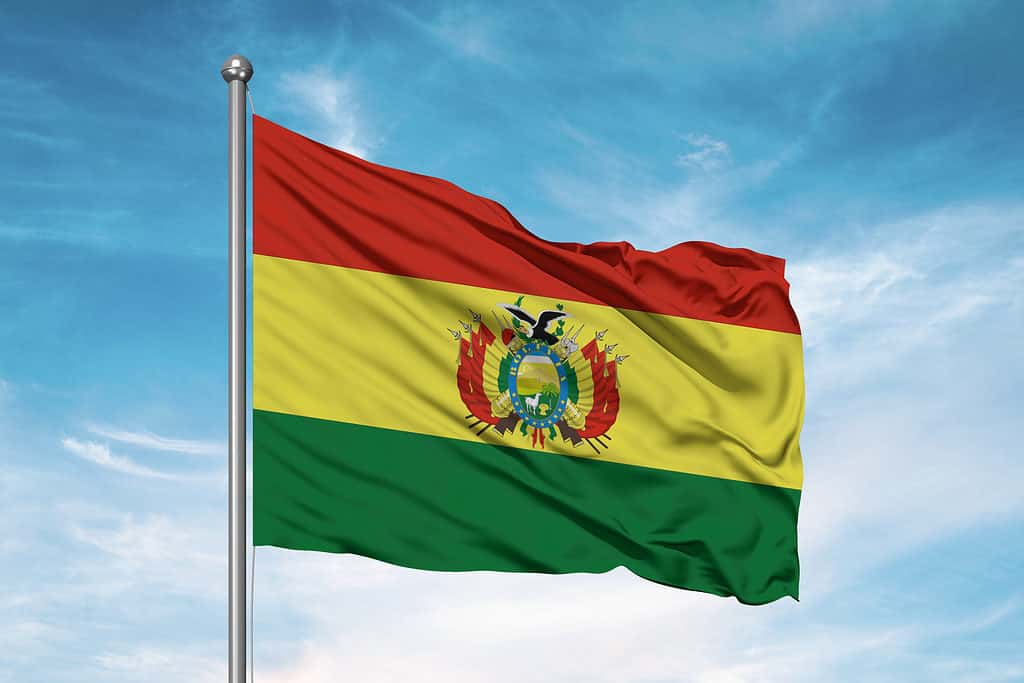
The flag of Bolivia represents the plurinational state of Bolivia.
©Design_Bank/Shutterstock.com
Flag of Bolivia, representing the Plurinational State of Bolivia. As a rule, it was first implemented in 1851. The Wiphala flag has been recognized as a dual flag since 2009. The Wiphala is recognized as a national symbol of Bolivia in the country’s updated constitution, which was adopted in 2009.
Design
The Bolivian flag has three horizontal stripes: the top one is red, the middle one is green, and the bottom one is yellow.
Symbolism
The green signifies the country’s fertile terrain and vast natural resources, while the red represents the blood lost by its citizens during the fight for independence. The yellow bar represents Bolivia’s abundance of natural resources. This rainbow of hues symbolizes Bolivia’s rich cultural heritage, vibrant present, and bright future.
The Flag of Ethiopia
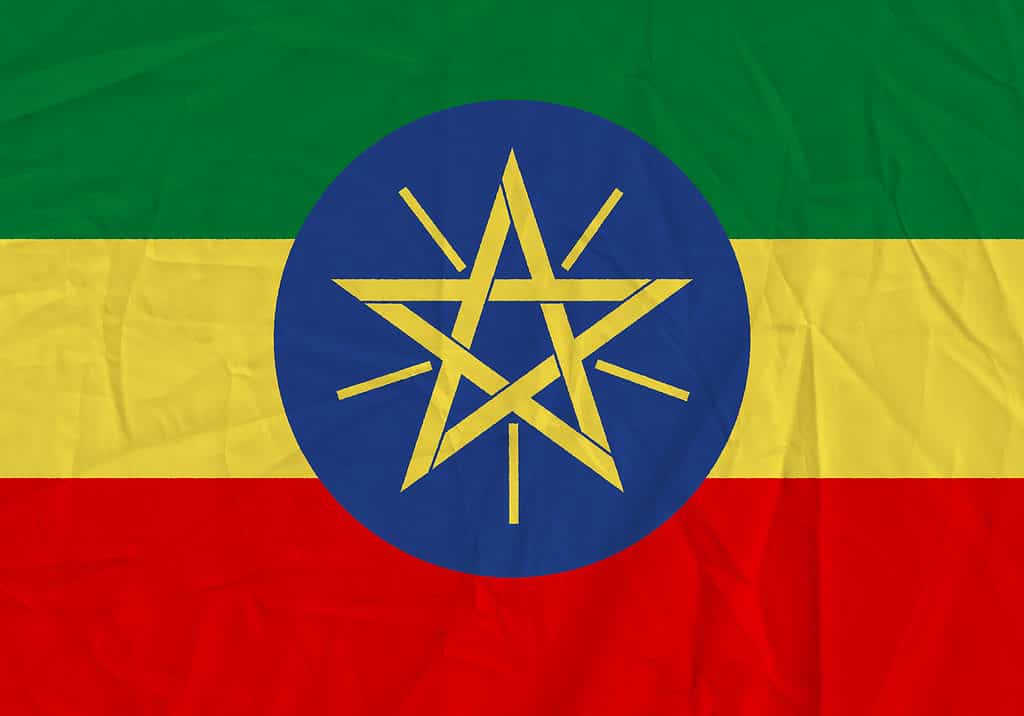
On October 31, 1996, Ethiopia adopted its current flag. The National Emblem, a golden pentagram on a blue disc, is overlaid in the middle of the tricolor, composed of green, yellow, and red.
©Olleg/Shutterstock.com
Ethiopia flies one of the world’s oldest flags. Because of its distinctive appearance and eye-catching hues, it is also among the most well-known. On 11 October 1897, Menelik II adopted the contemporary tricolor of green, yellow, and red; on 31 October 1996, the current flag was adopted.
Design
The Ethiopian flag is a vertical tricolor of green, yellow, and red, with the country’s emblem—a golden pentagram on a blue disc—superimposed in the center.
Symbolism
The flag’s red tint commemorates the lives lost by Ethiopian soldiers in their fight for freedom. To depict the country’s landscape and plants, green is used, while yellow indicates the country’s bright economic future. Combined, they symbolize Ethiopia’s rich heritage, vibrant culture, and bright future.
The Flag of Ghana

The national flag of Ghana was adopted on March 6th, 1957.
©Design_Bank/Shutterstock.com
The Blue Ensign of the British Gold Coast was replaced by the current Ghanaian flag. The flag was officially adopted on March 6, 1957, when the Dominion of Ghana gained its independence from the United Kingdom. Theodosia Okoh, a celebrated Ghanaian artist, created the design that same year. Flag flying ceased in 1964 but resumed the following year. The flag of Guinea-Bissau was inspired by this design (1973).
Design
The flag of Ghana consists of three stripes in a horizontal fashion: green, yellow, and red (from bottom to top). It has a five-pointed black star in the middle of the yellow stripe. The flag of the Ethiopian Empire was the first African flag to use these colors, and the flag of Ghana is the second, albeit the colors are reversed.
Symbolism
The red represents the lives lost, and the green reflects the abundance of Ghana’s natural resources and the wealth of the country. This country’s mineral wealth, especially its gold, is represented by the color yellow. In unison, these hues stand for the rich past, vibrant present, and promising future of Ghana.
The Flag of Guinea

The flag of Guinea is a vertical tricolor flag of red, yellow, and green.
©Design_Bank/Shutterstock.com
Along with the publishing of Guinea’s first Constitution on November 10, 1958, the country’s flag was formally adopted at that time.
Design
A vertical tricolor of green, yellow, and red forms Guinea’s flag (right to left). The leading movement at the time of independence was the Rassemblement Démocratique Africain, whose colors were adapted for the flag. The flag’s color scheme was taken from the flag of Ghana, which had been used since 1957.
Symbolism
The red stands for the blood of anti-colonialist martyrs, the toil of the working masses, and the hope for progress; the green for Guinea’s forests; and the yellow for the sun. Also, the pan-African colors, red, green, and yellow are symbols of unity and pride across the continent. The colors chosen represent the three parts of the national motto: Travail, Justice, Solidarité (or “Work, Justice, Solidarity”).
The Flag of Mali

The flag of Mali is a vertical tricolor flag of green, yellow, and red.
©Claudio Divizia/Shutterstock.com
On March 1, 1961, the present flag was officially adopted. Mali first flew its current flag on April 4, 1959, the day it officially joined the Mali Federation. The flag was identical but for a black Kanaga—the outline of a short man with his arms raised—on the yellow (golden) stripe. When Islamic fanatics in a country where 90% of the population is Muslim voiced their disapproval, the statue was taken down.
Design
The Mali flag is a tricolor with three equal vertical stripes. Hues are green, yellow (gold), and red, also the pan-African colors, from the hoist. Mali’s flag is nearly identical to that of Guinea’s, save for the fact that the colors are displayed backward.
Symbolism
The green represents the bounty of the land, the yellow its purity and mineral wealth, and the red its sacrifice in the fight for independence from the French.
The Flag of the Republic of Congo
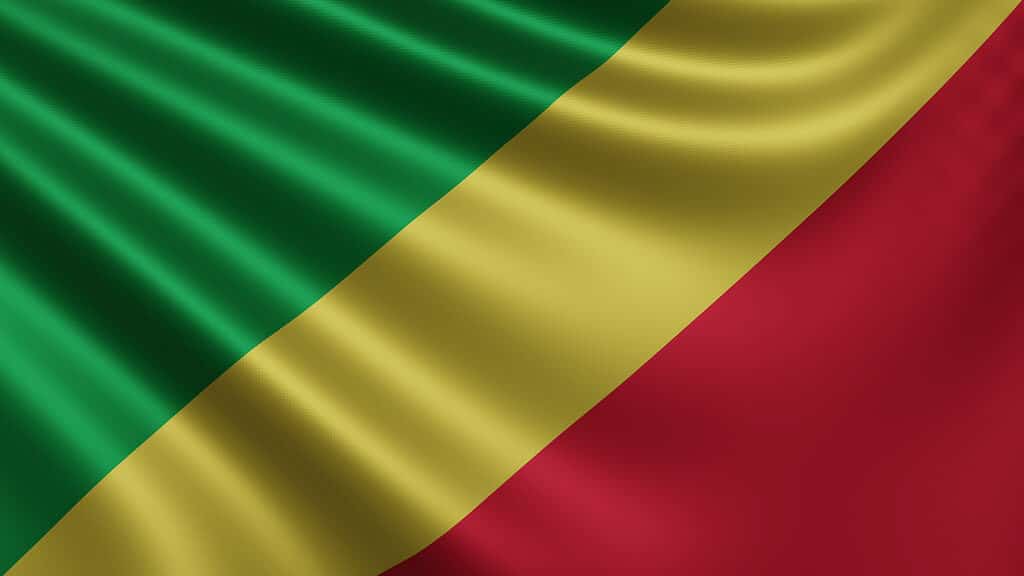
The flag of the Republic of Congo has a yellow band that runs diagonally from the bottom hoist side corner to the top right corner, with a green upper triangle and a red lower triangle.
©iStock.com/IFest
Independence from France occurred on September 15, 1959, and the Republic of the Congo’s current flag was officially approved that same day. Until the People’s Republic of the Congo was founded in 1970, this flag flew over the Republic of the Congo. With the change in government, the flag was updated to feature a red field with the People’s Republic coat of arms in the canton. Until the regime’s fall in 1991, this version was in use. The pre-1970 flag was swiftly returned by the new government.
Design
The colors green, yellow, and red make up the Republic of the Congo’s flag (left to right). The flag has three distinct sections: a green upper triangle, a yellow diagonal band that splits the flag in half from the hoist’s bottom corner, and a red lower triangle.
Symbolism
The red is said to stand for the lives lost in the fight for independence, the green for the country’s woods and agriculture, and the yellow for the warmth of the Congolese people and their noble spirit.
The Flag of Senegal
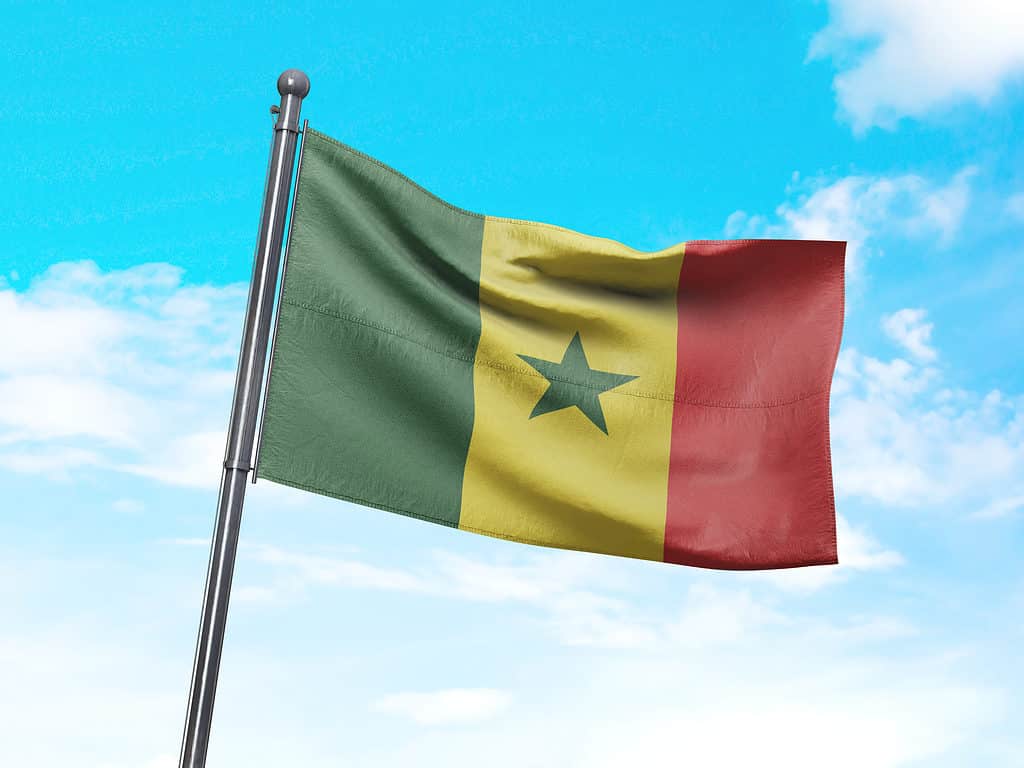
The Senegal people have flown their own flag since their independence.
©Hybrid Gfx/Shutterstock.com
The flag of Senegal was adopted in 1960 when Senegal gained independence from France. It is interesting to note that the colors of the flag are also those of the pan-African flag. This is likely no coincidence, as Senegal has always been a strong advocate for pan-Africanism.
Design
Senegal’s flag is a tricolor with a green five-pointed star in the middle of three vertical stripes of green, yellow, and red.
Symbolism
The flag of Senegal has recently evolved into a national symbol of pride and solidarity. The color green is both a symbol of the Prophet and a harbinger of a brighter future. For a country that places a premium on economic development, yellow might be seen as a representation of the fruits of its citizens’ labor. The color yellow is often associated with creativity and intelligence. The color red, which is associated with blood, also represents a fierce will to overcome poverty and its associated social injustices.
Click here to learn about every single flag in the world!
Burkina Faso

The Burkina Faso national flag is horizontally striped red and green with a central five-pointed yellow star and a 2:3 width-to-length ratio.
©Steve Allen/Shutterstock.com
Burkina Faso sits in West Africa, bordered by Niger, Benin, Mali, Togo and Ghana, and the Ivory Coast. Its population as of 2021 is 20,321,378. This landlocked country boasts an area of 274,223 km². The flag was adopted in 1983 after a coup put Thomas Sankara into power.
Design
The Burkina Faso national flag is horizontally striped red and green with a central five-pointed yellow star and a 2:3 width-to-length ratio.
Symbolism
The yellow star symbolizes the guiding light that powered the revolution. Red represents the revolution itself and green alludes to the country’s rich natural and agricultural resources.
São Tomé and Príncipe
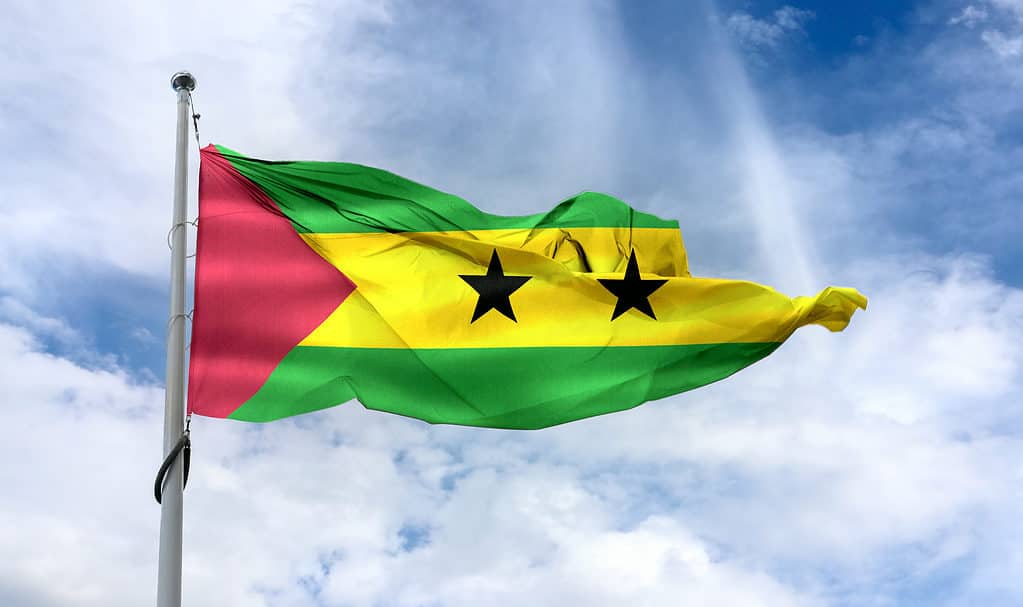
The flag of Sao Tome and Principe.
©iStock.com/Wirestock
São Tomé and Príncipe is part of a chain of volcanic islands near the equator off the west coast of Central Africa. The flag was adopted in 1975 when the country gained its independence, replacing the former flag of Portugal, which ruled the island during the colonial period.
Design
The flag sports a red triangle situated at the hoist, with a set of three horizontal green, yellow and green bands. Across the yellow band sits two black stars of Africa.
Symbolism
The yellow in the flag of São Tomé and Príncipe symbolizes the sun, as well as cocoa, a prominent crop produced there. Red represents the nation’s struggle for independence and equality. The green refers to the country’s abundant vegetation. The two black stars allude to the nation being part of Africa.
Benin
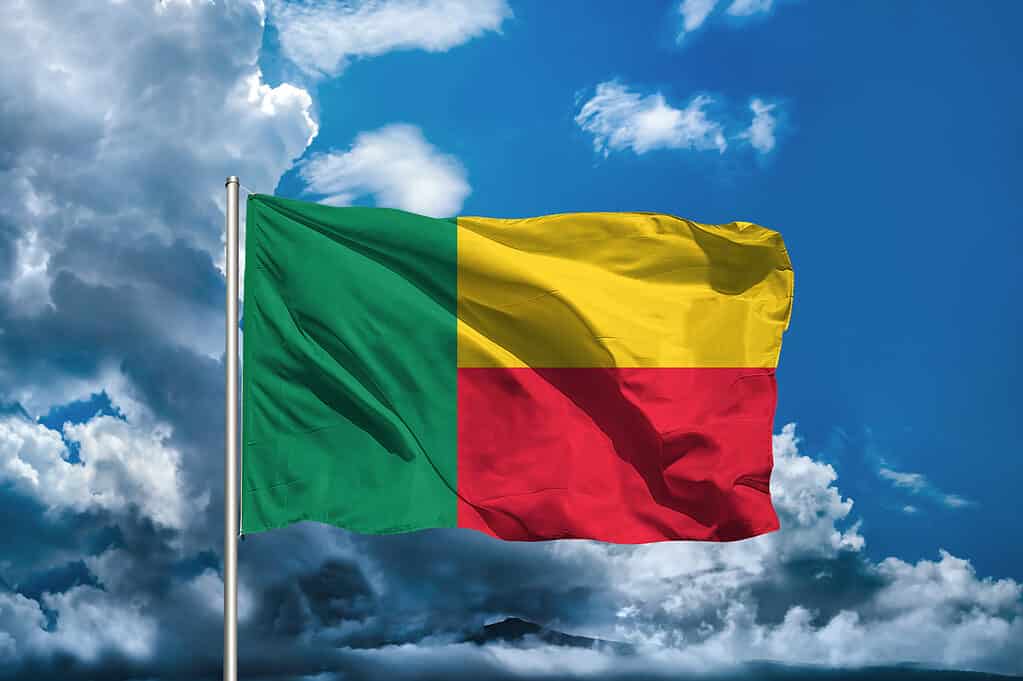
The colors of the Benin flag represent treasure, hope in democracy, and courage of its people.
©karim Abd albaky/Shutterstock.com
Benin has an interesting history, with the vodun (voodoo) religion originating there. This country, located in West Africa, is a destination for tourists who desire to witness wildlife such as at Pendjari National Park, where safaris showcase animals like elephants, hippos, and lions. Its flag was adopted in 1975, following a coup in 1972 which resulted in the country becoming the People’s Republic of Benin.
Design
The flag of Benin boasts a green vertical band at the hoist and a yellow and red vertical band on the fly side.
Symbolism
The red portion of the flag symbolizes the courage of the country’s ancestors. Yellow stands for the country’s wealth. Green represents democratic hope.
Togo
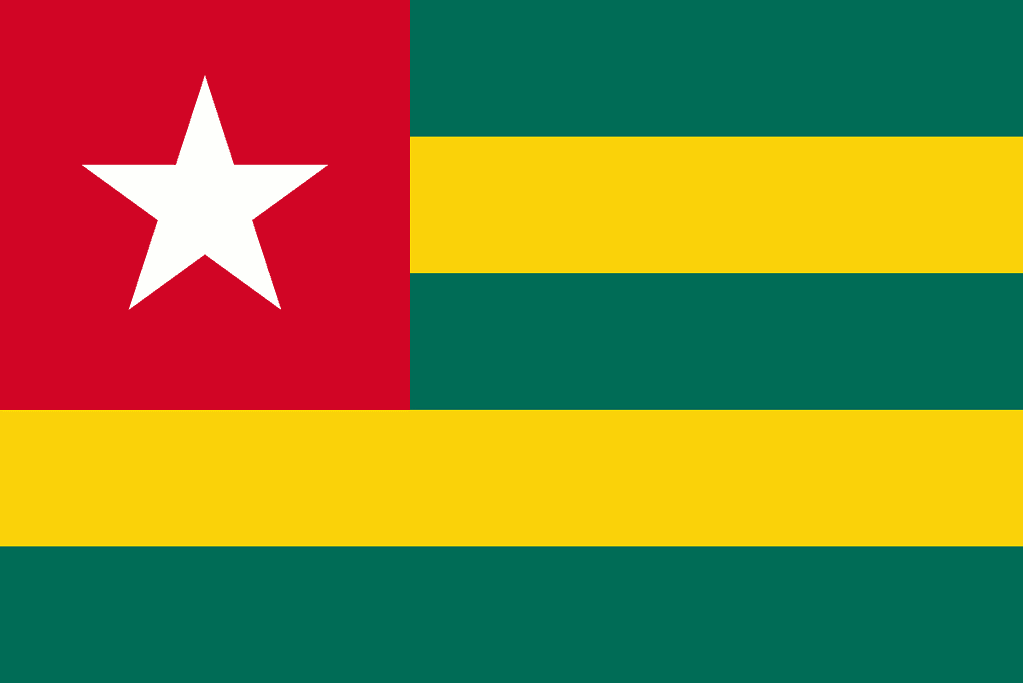
The flag of Togo was adopted by the nation in 1960.
Togo, a West African nation on the Gulf of Guinea, is known for its palm-lined beaches and hilltop villages. Its flag was adopted in 1960 following Togo’s independence from France.
Design
The Togo flag is characterized by five horizontal bands of green alternating with yellow from top to bottom. A red square in the upper left showcases a single white star. Its design is similar to the U.S. flag.
Symbolism
The green stripes on the flag represent hope, as well as the country’s forests, nature, and agriculture. The yellow stripes stand for natural resources. The fact that there are 5 total stripes alludes to the five regions of Togo. The red symbolizes bloodshed during the nation’s struggle for freedom, and the white star is a symbol of hope.
Guinea-Bissau
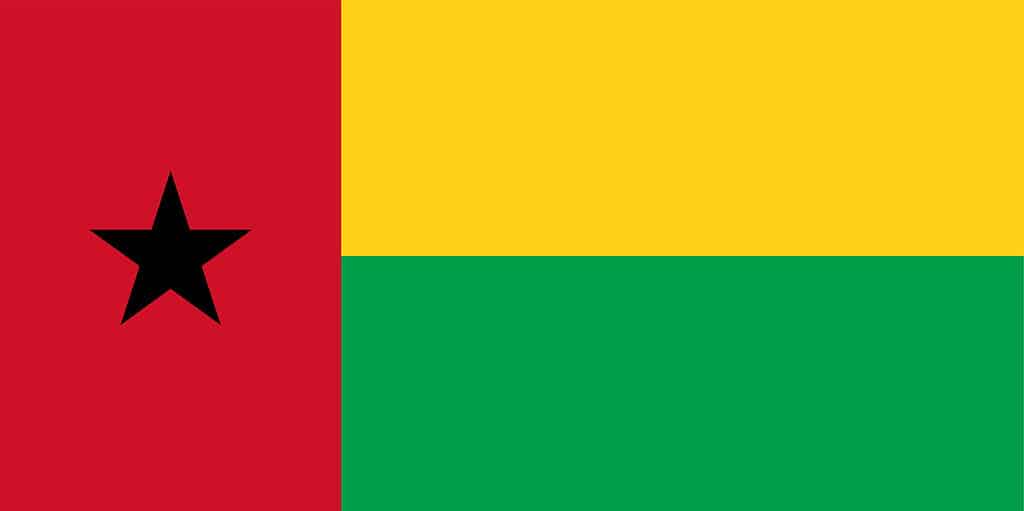
The main color elements of the flag are in horizontal bands of green, yellow, and red, representing forests, mineral wealth, and heroes’ blood.
©mapsandphotos/Shutterstock.com
Located on the Atlantic coast of West Africa, Guinea-Bissau is a tropical country popular for its wildlife and national parks. Its capital city is Bissau. Its flag was adopted following the country’s independence from Portugal in 1973.
Design
The flag design features a yellow and green horizontal line on the fly side, and a vertical red line to the left. A black 5-pointed star sits in the middle of the section.
Symbolism
The black star is officially the “black star of Africa,” which appears on many African flags. The red stands for bloodshed. Green represents the abundant forests in the country, while yellow represents gold and mineral wealth.
Summary Of The 12 Countries With Green, Yellow, and Red Flags in 2024
| Rank | Country |
|---|---|
| 1 | Bolivia |
| 2 | Ethiopia |
| 3 | Ghana |
| 4 | Guinea |
| 5 | Mali |
| 6 | Republic of Congo |
| 7 | Senegal |
| 8 | Burkina Faso |
| 9 | São Tomé and Príncipe |
| 10 | Benin |
| 11 | Togo |
| 12 | Guinea-Bissau |
Thank you for reading! Have some feedback for us? Contact the AZ Animals editorial team.

